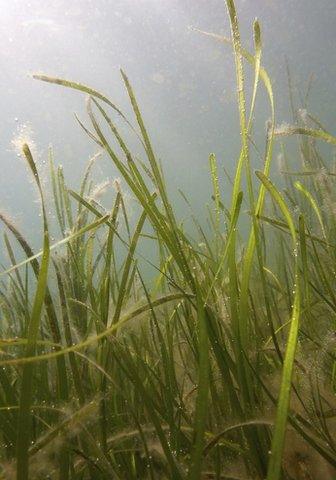Pollution blights UK seagrass meadows
- Published

Shutting out the light: Algae attach themselves to the leaves of seagrass plants
Pollution is having a damaging impact on UK seagrass meadow health, a new study has found.
Scientists based in Wales have shown that excessive amounts of nitrogen present in sewage and livestock waste is finding its way into coastal waters.
This encourages large populations of small algae to thrive and these are depriving the seagrass of essential light, stunting its growth.
The research is published in Frontiers in Plant Science, external.
Seagrass meadows are found in sandy and muddy locations around the UK. They are important for maintaining healthy animal populations, says Benjamin Jones from Cardiff University and the lead author on the study.
"In the UK alone, they provide a nursery habitat for a diverse range of marine life, which include cod, plaice, pollack and in places on the south coast like Studland Bay - seahorses," he told the BBC.
There is also evidence that these meadows are important in controlling atmospheric carbon. According to Mr Jones, seagrass is 35 times more efficient at capturing carbon than a typical tropical rainforest. Seagrass also stabilises coastal sediments and prevents coastal erosion.
In short, this marine plant performs a number of really important environmental tasks.
Given the meadows' coastal location, these key habitats are potentially exposed to nitrogen-rich pollution from human sewage and animal waste. The full scale of this exposure and its effects on the health of seagrass have been unclear, however.
To get a better idea of how seagrass was being affected by sewage pollution, Mr Jones and colleagues from the Universities of Cardiff and Swansea studied plant communities in 11 UK locations. Ten of these were located in European marine protected sites.
At each sampling site, they collected plants growing at up to three metres under the sea.
The researchers focussed on leaves, leaving the roots intact so that the plants could grow back.
Once collected, the leaves were analysed in the lab for the presence of different isotopes of nitrogen.
Tell-tale signs
An atom consists of a nucleus containing particles called protons and neutrons. Around this nucleus swirls a cloud of electrons.
In every neutral atom, the number of electrons and protons is equal. It is this number that effectively defines what the atom is.
But the number of neutrons in the same type of atom can differ and these alternative forms are called isotopes.
The most frequent version of nitrogen has seven protons and seven neutrons in its nucleus and is called nitrogen-14.
Nitrogen-15 differs from this nitrogen because it contains an additional neutron and this makes it slightly heavier.
Measuring the levels of each nitrogen isotope present in the seagrass leaves provided important insights into the state of the water where the plant was growing, as Mr Jones explained: "It allows us to keep trace of where nutrients present in seagrass leaves have come from. Different sources of nutrients have different levels of nitrogen-15".
"The more nitrogen-15 we measure, relative to the amount of nitrogen-14, the more certain we are that the nutrients the plant has been exposed to contain sewage and livestock waste."
When the researchers analysed their data it was clear that the coastal waters of the UK contained varying amounts of the potentially harmful pollutants.
Seagrass from Southend on Sea had around three times the level of nitrogen-15 than plants growing at a site off the Scilly Isles.
In general, samples collected from sites associated with high habitation had the most heavy nitrogen and were also in a poorer state. There was less plant cover and the leaves of individuals plants were smaller.
"Nutrient levels are probably the biggest problem for seagrasses around the UK. The nitrogen levels were around 75% higher in the leaves compared with those analysed from other regions around the globe," Mr Jones told the BBC.
In the dark
The team's research also revealed part of the reason why this excess nitrogen was so damaging.
It encouraged the growth of tiny marine algae, many of which were growing directly on the surface of the seagrass leaves. These smother the seagrass, effectively starving them of the light they need to carry out photosynthesis.
"Seagrass growth isn't limited by nutrients, but is limited by light and in the UK that means that they are usually found down to a depth of only seven metres.
"To put that in perspective, the same species grows at depths of 35m in the Gulf of California because the water clarity is so much better," Mr Jones said.
The authors argue that whole-scale change in the way the UK controls and monitors sewage and livestock waste is needed to improve the seagrass meadows and the coastal environment in general.
The researchers have launched a citizen science project and are encouraging people to download an app, external called the Seagrass Spotter to their mobile devices.
This will enable anyone who wants to take part to record sightings of seagrass and upload the observations to the researchers' database.